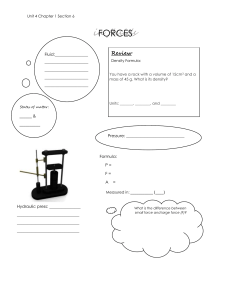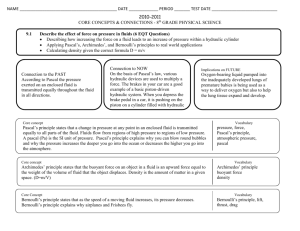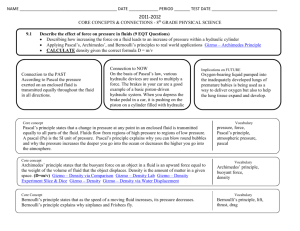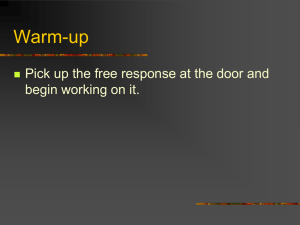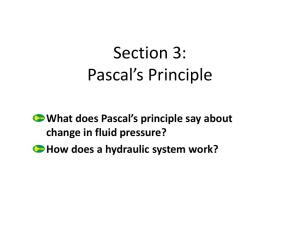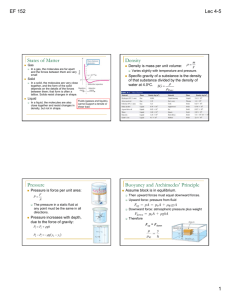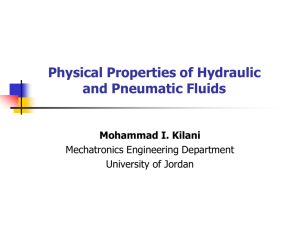Forces in fluids
advertisement
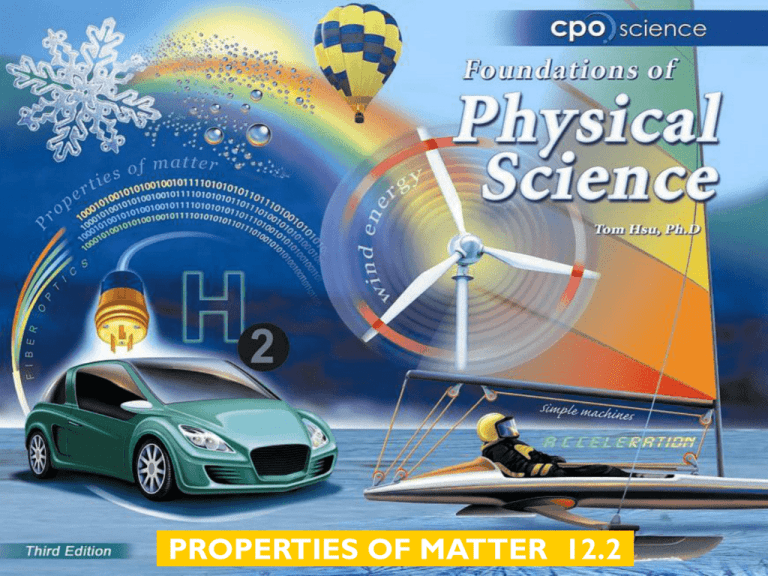
PROPERTIES OF MATTER 12.2 Chapter Twelve: Properties of Matter 12.1 Properties of Solids 12.2 Properties of Fluids 12.3 Buoyancy Chapter 12.2 Learning Goals Explain how pressure is created in fluids. Discuss differences between the density of solids and fluids. Apply Bernoulli’s principle to explain how energy is conserved in fluids. 12.2 Properties of Fluids A fluid is defined as any matter that flows when force is applied. Liquids like water or silver are kinds of fluid. 12.2 Pressure A force applied to a fluid creates pressure. Pressure acts in all directions, not just the direction of the applied force. 12.2 Forces in fluids Forces in fluids are more complicated than forces in solids because fluids can change shape. 12.2 Units of pressure The units of pressure are force divided by area. One psi is one pound per square inch. 12.2 Units of pressure The S.I. unit of force is the pascal. One pascal (unit of force) is one newton of force per square meter of area (N/m2). 12.2 Pressure If your car tires are inflated to 35 pounds per square inch (35 psi), then a force of 35 pounds acts on every square inch of area inside the tire. What might happen if you over-inflate a tire? 12.2 Pressure On the microscopic level, pressure comes from collisions between atoms. Every surface can experience a force from the constant impact of trillions of atoms. This force is what we measure as pressure. 12.2 Pressure In a car engine high pressure is created by an exploding gasoline-air mixture. 12.2 Energy conservation and Bernoulli’s Principle Streamlines are imaginary lines drawn to show the flow of fluid. Bernoulli’s principle tells us that the energy of any sample of fluid moving along a streamline is constant. 12.2 Bernoulli’s Principle Bernoulli’s principle says the three variables of height, pressure, and speed are related by energy conservation. 12.2 Three Variables and Bernoulli’s Principle If one variable increases along a streamline, at least one of the other two must decrease. For example, if speed goes up, pressure goes down. 12.2 The air foil One of the most important The difference in applications of Bernoulli’s principle is is thewhat airfoil pressure shape of wings on a plane. creates the lift force When a plane is moving, that supports the plane the pressure on the top in the of air.the wings is surface lower than the pressure beneath the wings. 12.2 Hydraulics and Pascal’s Principle Hydraulic lifts and other hydraulic devices use pressure to multiply forces and do work. The word hydraulic refers to anything that is operated by a fluid under pressure. Hydraulic devices operate on the basis of Pascal’s principle, named after Blaise Pascal. 12.2 Hydraulics and Pascal’s Principle Pascal’s principle states that the pressure applied to an incompressible fluid in a closed container is transmitted equally in all parts of the fluid. An incompressible fluid does not decrease in volume when pressure is increased. 12.2 Hydraulics and Pascal’s Principle A small force exerted over a large distance is traded for a large force over a small distance. 12.2 Pressure Pressure is force divided by area. 12.2 Force You can calculate the force exerted if you know the pressure and area. Solving Problems On a hydraulic lift, 5 N of force is applied over an area of 0.125 m2. What is the output force if the area of the larger cylinder is 5.0 m2? Solving Problems 1. Looking for: …output force 2. Given …input force = 5 N; input area = .125 m2 ; output area = 5 m2 3. Relationships: Pressure = Force Force = P x A Area Solving Problems 4. Solution Solve for pressure using input force. Pressure = 5N .125m2 = 40 N/m2 Use Pascal’s law principle and use equivalent pressure to solve for output force. Force = 40 N x 5 m2 = m2 200 N 12.2 Viscosity Viscosity is the property of fluids that causes friction. Viscosity is determined in large part by the shape and size of the particles in a liquid. 12.2 Viscosity and temperature As the temperature of a liquid increases, the viscosity of a liquid decreases. Increasing the kinetic energy of the substance allows the particles to slide past one another more easily. Investigation 12C Density of Fluids Key Question: What is the maximum load a boat can hold before sinking? How is the maximum load affected by the density of the water in which the boat floats?
